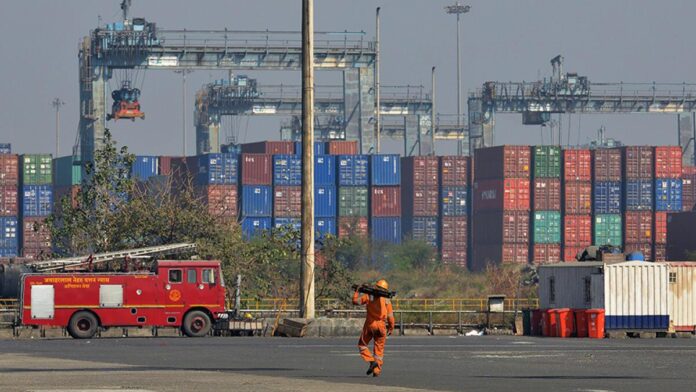
A view of the container terminal at the Jawaharlal Nehru Port Trust in Mumbai. | Photo: Prashant Nakwe/The Hindu
India’s rapid trade growth is planned around containerized transport of goods. But there’s a key logistical bottleneck. India just does not make enough containers.
The container can be seamlessly multimodal – rail, ship and road. It has revolutionized world trade by rapidly cutting transportation time, port delays and so on. It can be said that the untold story of swift trade movements that have enabled globalization is actually the containerization of goods.
Container boxes are highly standardized in dimensions and cargo-carrying capacities. Once the cargo is stuffed inside the container and sealed after Customs clearance, the boxes can be moved over long distances without any disturbance to the cargo.
India has sought to increase container handling capacity in various ports to boost exports. Ambitious new ventures such as the Vadhavan and Galathea Bay ports as well as the multimodal India Middle East Europe Economic Corridor are built around containers.
India’s container market is expected to more than double from 11.4 million TEU in 2023 to 26.6 million TEU by 2028. One 20-ft container box is equivalent to 1 TEU. India manufactures around 10,000 to 30,000 container boxes a year and this production can therefore support only a fraction of the projected doubling. China, in comparison, manufactures 2.5 to 3 million container boxes per year.
In India, it takes $3,500 to $4,800 to make one container whereas in China it costs $2,500 and $3,500. India therefore has to lease the container boxes, mostly from China. All our plans for ramping up trade are put at risk by inadequate container production within India.
Shortage of containers often jacks up freight rates in the country. Congestion at Indian ports mounts.
Indian ports are at a strategic location on the East-West trade route but cannot aspire to be hub ports because of container shortage. As a result, Colombo, Dubai and Hong Kong draw mother ship traffic, not Indian ports.
Indian shippers are forced to depend on short distance feeder vessels where the providers of containers do not see much business and profits. This in turn, leads to higher tariff for our shippers.
The crisis in West Asia often casts a shadow on ship traffic through Suez Canal. Circumnavigating Africa lengthens voyages by 10 to 15 days and container availability takes a hit as a result.
The Russia-Ukraine war has led to closure of some ports, changes in routes and insurance costs, as well as enhanced container freight rates. Piracy has also increased freight costs. In these conditions, it makes sense to build a large and secure supply of container boxes.
What the government can do
The government has come up with Make In India initiatives to promote indigenous production of container boxes either in PPP mode between the Container Corporation of India and private players or by directly incentivizing private production. Direct subsidy and viability gap funding are two support measures available with the government.
A few more measures can help. Reduction in charges of repositioning and storage of empty containers, a short-term measure, can help to ease the shortage of containers. Enhancing container yard capacities at Indian ports can promote business.
The key would be to ensure that when scaled up, the cost of production comes down to global levels. The government has mulled Production Linked Incentives (PLI) but they need to be implemented.
Incentives, including relaxation of GST, to the manufacturers of raw material required for containers will help in reducing input costs of container production. Incentives to Indian shippers using Indian containers and facilitating long-term contracts between shippers and Indian container manufacturers can build market confidence.
Mandating the use of Indian-made containers enhances domestic demand resulting in better prospects for the sector. The development of a tracking and tracing mechanism of containers through a Unified Logistics Interface Platform (ULIP) and Logistics Data Bank (LDB) by the government can reduce the turnaround time of export containers and ease their shortage.
(N. Bhanu Prakash holds the position of Associate Professor and heads the School of Maritime Management at the Indian Maritime University, Visakhapatnam Campus. His specialisation is in the area of logistics and supply chain management. His research interests are ports and shipping management.)
Published – October 12, 2024 12:40 pm IST
#India #lot #containers #boost #trade
